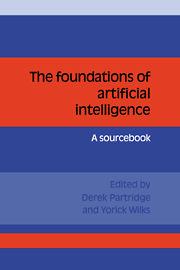Book contents
- Frontmatter
- Contents
- List of contributors
- Preface
- Acknowledgments
- 1 Introduction
- 2 The formal foundations of AI
- 3 Levels of theory
- 4 Programs and theories
- 5 The role of representations
- 6 The role of programs in AI
- 7 Rational reconstruction as an AI methodology
- Three Novelties of AI: theories, programs and rational reconstructions
- AM: a case study in AI methodology
- 8 Is AI special in regard to its methodology?
- 9 Does connectionism provide a new paradigm for AI?
- 10 The role of correctness in AI
- 11 Limitations on current AI technology
- 12 Annotated bibliography on the foundations of AI
- Index of names
AM: a case study in AI methodology
Published online by Cambridge University Press: 03 May 2010
- Frontmatter
- Contents
- List of contributors
- Preface
- Acknowledgments
- 1 Introduction
- 2 The formal foundations of AI
- 3 Levels of theory
- 4 Programs and theories
- 5 The role of representations
- 6 The role of programs in AI
- 7 Rational reconstruction as an AI methodology
- Three Novelties of AI: theories, programs and rational reconstructions
- AM: a case study in AI methodology
- 8 Is AI special in regard to its methodology?
- 9 Does connectionism provide a new paradigm for AI?
- 10 The role of correctness in AI
- 11 Limitations on current AI technology
- 12 Annotated bibliography on the foundations of AI
- Index of names
Summary
Introduction
Artificial intelligence is still a relatively young science, in which there are still various influences from different parent disciplines (psychology, philosophy, computer science, etc.). One symptom of this situation is the lack of any clearly defined way of carrying out research in the field (see D. McDermott, 1981, for some pertinent comments on this topic). There used to be a tendency for workers (particularly Ph.D. students) to indulge in what McCarthy has called the “look-ma-no-hands” approach (Hayes, 1975b), in which the worker writes a large, complex program, produces one or two impressive printouts and then writes papers stating that he has done this. The deficiency of this style of “research” is that it is theoretically sterile – it does not develop principles and does not clarify or define the real research problems. What has happened over recent years is that some attempt is now made to outline the principles which a program is supposed to implement. That is, the worker still constructs a complex program with impressive behaviour, but he also provides a statement of how it achieves this performance. Unfortunately, in some cases, the written “theory” may not correspond to the program in detail, but the writer avoids emphasizing (or sometimes even conceals) this discrepancy, resulting in methodological confusion. The “theory” is supposedly justified, or given empirical credibility, by the presence of the program (although the program may have been designed in a totally different way); hence the theory is not subjected to other forms of argument or examination.
Information
- Type
- Chapter
- Information
- The Foundations of Artificial IntelligenceA Sourcebook, pp. 247 - 266Publisher: Cambridge University PressPrint publication year: 1990
Accessibility standard: Unknown
Why this information is here
This section outlines the accessibility features of this content - including support for screen readers, full keyboard navigation and high-contrast display options. This may not be relevant for you.Accessibility Information
- 4
- Cited by
